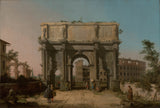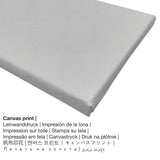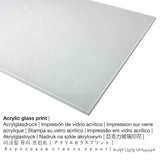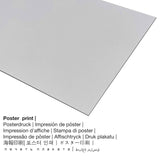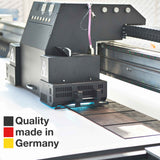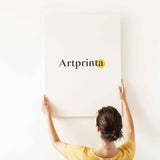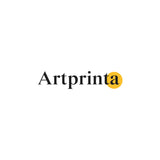Canaletto, 1742 - Nlele nke Arch of Constantine na Colosseum - mbipụta nka mara mma.
Ụtụ gụnyere. Mbupu gbakọrọ na ndenye ọpụpụ.
Nkọwa izizi sitere na webụsaịtị ihe ngosi nka (© Nwebiisinka - Ụlọ ihe ngosi nka J. Paul Getty - Ụlọ ihe ngosi nka nke J. Paul Getty)
Canaletto specialized in vedute, or views, of Venice that he sold to tourists on the Grand Tour in the 1700s. For a brief time in the 1740s, he painted scenes of contemporary life set around the principal monuments of ancient Rome, based either on drawings made during an earlier visit to Rome or on engravings by other artists. Both groups of his views appealed to the traveler as well as the antiquarian.
Seen through the central bay of the Arch of Constantine is the Colosseum, which Canaletto shifted to the left in the interests of compositional design. Figures converse, stroll, or carry out daily chores in the vicinity of these ancient buildings. To the left, a lone man sits on ruins with his back to the viewer, perhaps sketching or writing. Wealthy tourists and their servants laden with goods contrast with the poor Roman natives who have nothing, such as the woman who lies against the Arch or the man with a cane at the right. In this painting, Canaletto seems to remark on the gulf between Rome's ancient glory and the city's current impoverished state.
Nchịkọta ngwaahịa zuru ezu
View of the Arch of Constantine with the Colosseum is an artpiece made by the painter Canaletto. The artwork can be viewed in in the digital art collection of The J. Paul Getty Museum, which is part of the J. Paul Getty trust and is one of the world's largest arts organizations worldwide. It seeks to inspire curiosity about, and enjoyment and understanding of, the visual arts by collecting, conserving, exhibiting, and interpreting works of art of outstanding quality and historical importance.. This artpiece, which belongs to the public domain is being supplied with courtesy of The J. Paul Getty Museum.Moreover, the work of art has the following creditline: . On top of that, alignment is odida obodo na oke nke 3: 2, nke pụtara na ogologo bụ 50% ogologo karịa obosara. Canaletto was a painter of Italian nationality, whose art style can primarily be classified as Baroque. The artist was born in 1697 ma gafee na afọ nke 71 na 1768.
Họrọ ngwa ngwaahịa gị
In the dropdown lists right next to the product offering you can select the size and material of your choice. We allow you to pick your favorite size and material among the following product individualization options:
- Poster (akwa akwa akwa): The Artprinta poster print is a UV printed sheet of canvas paper with a granular texture on the surface. Please note, that depending on the absolute size of the poster we add a white margin of something between 2-6cm around the print to facilitate the framing with your custom frame.
- Bipụta na iko acrylic (nke nwere ezigbo mkpuchi iko n'elu): The acrylic glass print, often referred to as a print on plexiglass, changes the original artwork into home décor. What is more, it is a distinct alternative option to canvas or dibond fine art prints. The work of art is being custom-made with modern UV print machines. With an acrylic glass fine art print sharp contrasts plus small artwork details will be visible because of the subtle tonal gradation in the picture.
- Kwaaji: A printed canvas, which shall not be confused with an artwork painted on a canvas, is a digital image printed from an industrial printing machine. Furthermore, a canvas print makes a cosy and pleasant ambience. Hanging your canvas print: The great advantage of canvas prints is that they are relatively low in weight. That means, it is quite simple to hang the Canvas print without the help of any wall-mounts. That is why, canvas prints are suited for any type of wall.
- Mbipụta nke aluminom: Aluminium Dibond prints are metal prints with an impressive depth. Colors are vivid and luminous, details of the print appear clear and crisp. This print on Aluminum Dibond is one of the most demanded entry-level products and is a stylish way to showcase art, as it puts the viewer’s focus on the replica of the artwork.
Ozi ndabere gbasara onye na-ese ihe
| Ihe nkiri: | Canaletto |
| okike onye nka: | nwoke |
| Nationality: | Italian |
| Ọrụ nke onye na-ese ihe: | onye na-ese ihe |
| Obodo obibi: | Italy |
| Otu nka: | nna ukwu ochie |
| Ụdị nka: | Baroque |
| Afọ ọnwụ: | 71 afọ |
| A mụrụ: | 1697 |
| Afọ nwụrụ: | 1768 |
Ozi ndabere gbasara ọrụ nka pụrụ iche
| Aha nke ọrụ nka: | "View of the Arch of Constantine with the Colosseum" |
| Nhazi: | sere |
| Otu izugbe: | nka ochie |
| Time: | 18th narị afọ |
| Afọ nka: | 1742 |
| Afọ nka: | karịa afọ 270 |
| Ụlọ ihe ngosi nka / mkpokọta: | Ụlọ ihe ngosi nka nke J. Paul Getty |
| Ebe ngosi nka: | Los Angeles, California, Njikota Obodo Amerika |
| Ebe nrụọrụ weebụ ihe ngosi nka: | Ụlọ ihe ngosi nka nke J. Paul Getty |
| Ikikere nke ihe osise: | ngalaba ọha |
| Site n'aka: | Ụlọ ihe ngosi nka nke J. Paul Getty |
Product ọmụma
| Ụdị edemede: | mmepụta nka |
| Usoro mmeputakwa: | dijitalụ mmeputakwa |
| Usoro mmepụta: | mbipụta dijitalụ |
| Nlụpụta: | emere na Germany |
| Ụdị ngwaahịa: | mmepụta ihe na-achọ |
| Ojiji ngwaahịa: | ịchọ mma mgbidi, ihe ndozi ụlọ |
| Nhazi: | usoro odida obodo |
| Njikwa oyiyi: | 3:2- ogologo: obosara |
| Mmetụta ihe onyonyo: | ogologo bụ 50% ogologo karịa obosara |
| Akwa ngwaahịa dị: | Mbipụta kwaaji, mbipụta ọla (aluminium dibond), mbipụta enyo acrylic (nwere ezigbo mkpuchi iko), mbipụta akwụkwọ mmado (akwụkwọ kwaaji) |
| Kanvas n'elu etiti ihe ndọtị (mbipụta akwa akwa): | 30x20cm - 12x8", 60x40cm - 24x16", 90x60cm - 35x24", 120x80cm - 47x31", 150x100cm - 59x39" |
| Mbipụta iko acrylic (nke nwere ezigbo mkpuchi iko): | 30x20cm - 12x8", 60x40cm - 24x16", 90x60cm - 35x24", 120x80cm - 47x31" |
| Mpempe akwụkwọ mmado (akwụkwọ kwaaji) nha dị iche iche: | 60x40cm - 24x16", 90x60cm - 35x24", 120x80cm - 47x31" |
| Nhọrọ nha mbipụta aluminom: | 30x20cm - 12x8", 60x40cm - 24x16", 90x60cm - 35x24", 120x80cm - 47x31" |
| Nhazi mbipụta nka: | na-enweghị etiti |
Ihe dị mkpa: We try in order to depict the art products as accurate as possible and to illustrate them visually. Although, the colors of the print materials, as well as the printing may differ slightly from the presentation on the device's monitor. Depending on the settings of your screen and the condition of the surface, not all color pigments will be printed one hundret percent realistically. Considering that all art prints are printed and processed manually, there might as well be minor variations in the motif's exact position and the size.
Nwebiisinka © | Artprinta (www.artprinta.com)

